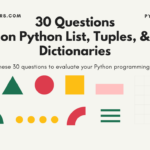LangChain is a toolkit for building apps powered by large language models like GPT-3. Today, we’ll see how to create a simple LangChain program in Python.
How to Integrate LangChain with Python
Think of LangChain as Legos for AI apps – it helps them connect to powerful models for creating text generators, chatbots, and question answerers. It got support from developers as a part of an open-source project. They helped it prototype and deploy with AI-powered apps. Let’s explore how to use it in Python.
Also Read: The Difference Between ChatGPT and GPT4
LangChain can unlock a world of possibilities for building apps powered by language. Let’s try to understand – What is it, what can we do with it, and how to use it.
What is LangChain?
It is a special framework designed to enable apps to understand and generate human-quality text.
- LangChain is like a toolbox for building apps that use language models (like GPT-3 or Jurassic-1 Jumbo).
- It helps you connect different parts of your app smoothly.
- It can seamlessly integrate with apps enabling them to understand and respond intelligently.
Related: Top 20 ChatGPT Alternatives You Should Try
Key Features
It brings many cool features to facilitate app development.
- Seamless integration with various LLM providers: LangChain supports popular providers like OpenAI, Cohere, and AI21 Labs, giving you flexibility in choosing the best model for your needs.
- Chaining capabilities: It empowers you to combine multiple LLM calls and other tools into intricate workflows, enabling more complex and sophisticated applications.
- Data augmentation: Easily integrate external data sources to enrich your language generation tasks, resulting in more informed and contextually relevant responses.
- Memory management: Preserve information across interactions to create more natural and consistent conversations or tasks.
How to Use LangChain with Python
Find the simple steps to help you get started with LangChain using Python.
Install LangChain Module
To start working with it, you first need to Install it. For this, open your terminal or command prompt and type the following command:
pip install langchainChoose an LLM Provider
Once installed, choose a language model provider: You must sign up with a provider like OpenAI or Cohere to access their language models.
- Select a language model provider that aligns with your needs and budget. Popular options include:
- OpenAI (offers GPT-3 models in various sizes)
- Cohere (provides a suite of models, including text-DaVinci-003)
- AI21 Labs (creators of Jurassic-1 Jumbo)
- Sign up for an account with your chosen provider to obtain API keys or access tokens necessary for using their models.
Must Read: Python Tutorial – Basic to Advanced
Create a Python Program Using LangChain
To use it, firstly, import the specific LLM you want to use from the lang chain’s LLMS module:
from langchain.llms import OpenAI # Example for OpenAIIn the next step, you should instantiate the LLM with your provider’s API key or token and any desired model configuration:
llm = OpenAI(api_key="your_api_key", temperature=0.7) # Adjust temperature for creativityAfter this, you can start to run the AI prompts. Use the LLM’s run() method to send prompts to the language model and receive responses:
prompt = "Write a poem about a robot who falls in love with a toaster."
response = llm.run(prompt)
print(response)LangChain with Python: Examples
Let’s begin to learn with some basic examples first.
Example#1: Basic Text Generation in Python
from langchain.llms import OpenAI
llm = OpenAI(temperature=0.7) # Adjust temperature for creativity
prompt = "Write a poem about a robot who falls in love with a toaster."
response = llm.run(prompt)
print(response)Example#2: Python Program to Answer a Question
prompt = "What is the meaning of life?"
response = llm.run(prompt)
print(response)Example#3: Python LangChain to Translate Text
from langchain.llms import Cohere
llm = Cohere(model_name="text-davinci-003") # Cohere's translation model
prompt = "Translate this sentence into Spanish: Hello, how are you?"
response = llm.run(prompt)
print(response)Advanced Features of LangChain
Beyond basic text generation and translation, LangChain offers several advanced features for building sophisticated language-driven applications:
Chaining
Think of LangChain as a supercharged glue for your AI toolbox. Instead of dealing with individual modules for tasks like parsing text, generating responses, or calling APIs, you can string them together with chain-like building blocks.
Example: Create a research assistant in Python that can do the following:
- Takes a research topic as input.
- Uses an LLM to query academic databases and gather relevant articles.
- Analyzes the articles with another LLM, extracting key findings and arguments.
- Finally, it can summarize the research in a concise and informative way.
Data Augmentation
Don’t limit your language models to generic prompts. LangChain lets you integrate external data sources like datasets, APIs, or even your own user interactions into the generation process. This enriches the context and leads to more nuanced and relevant responses.
Example: Create a personalized recipe generator that considers the user’s dietary restrictions, favorite ingredients, and past recipe preferences. LangChain can access relevant food databases and combine that information with the user’s input to generate unique and personalized recipes.
Memory Management
Remember those frustrating chatbots that forget everything you just told them? LangChain’s memory component allows you to maintain context across multiple interactions. This fosters more natural and engaging conversations.
Example: Develop a customer service chatbot that remembers a user’s past inquiries and previous orders. This lets the chatbot provide personalized recommendations, troubleshoot issues efficiently, and build a rapport with the customer.
Debugging and Evaluation
Building LLM-driven applications is exciting, but it can also be challenging. LangChain provides tools like LangSmith, a developer platform specifically designed for debugging, testing, and monitoring your applications. LangSmith gives you insights into how your prompts are performing, helping you optimize your applications for accuracy and effectiveness.
What Can You Do With It?
LangChain can unlock a whole world of possibilities when it comes to building apps powered by language. Here are just a few things you can do with it:
Get Creative
Think of it as a playground for your creativity, where AI fuels your ideas and lets you shape them into something truly original.
- Generate text: Write poems, scripts, musical pieces, emails, code, and more – the possibilities are endless!
- Translate languages: Break down language barriers and communicate with people around the world.
- Answer questions: Create chatbots that can answer your questions about anything, from the weather to complex scientific topics.
- Tell stories: Craft engaging narratives that capture your audience’s imagination.
Boost Productivity
LangChain can boost productivity in many ways. Check out a few below.
- Summarize documents: Get the gist of long texts in a flash, saving you valuable time.
- Extract information: Pull key details from data sets and analyze them to gain insights.
- Code completion: Write code faster and more efficiently by letting LangChain suggest the next line.
- Automate tasks: Automate repetitive tasks that involve text manipulation, like creating reports or generating marketing copy.
Connect with People
It can bridge the gap between hearts and minds, empowering you to connect with people in ways never before imagined:
- Build chatbots: Create chatbots that can have natural conversations with your users, provide support, answer questions, and even make personalized recommendations.
- Develop virtual assistants: Make your life easier with a virtual assistant that can handle everything from scheduling appointments to booking travel.
- Personalize experiences: Tailor your apps and websites to individual users based on their preferences and needs.
Remember, LangChain is just a toolbox. It’s your creativity and ingenuity that will unlock its full potential. So, go ahead and develop fantastic language-powered applications!
We hope, by now you acquired a fine understanding of LangChain’s capabilities and can explore its potential for your next Python projects.
Quick Reference
All the very best,
Team TechBeamers









